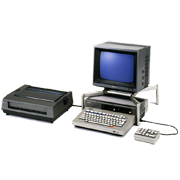Sony introduced the SMC-70 microcomputer system, which was distinguished by its 16-color graphics function, for business applications in October 1982 starting in the United States. It began selling the SMC-70 in Japan on December 1, 1982. Domestic market systems could display Japanese characters with the addition of kanji-character memory. This was the first personal computer system to make use of 3.5-inch micro-floppy disks developed by Sony.
The SMC-70 itself consisted of a controller, with a built-in keyboard, and a power supply unit. By connecting peripherals and various optional units to the SMC-70, it was possible to construct many kinds of systems ranging from hobbyist systems to word processing, tabulation, and other business application systems. Options included a 3.5-inch micro-floppy disk drive and other external storage units, printers, and displays as well as six different plug-in units that gave extended functionality to the SMC-70. Sony BASIC was preinstalled on the SMC-70 and optional software programs included CP/M and Sony Disk BASIC.
The SMC-70 system with the configuration above had the following features.
- 1. Multiple display functions
- The SMC-70's screen was distinctive in that it had three screen types — a character display, a graphics display, and a border area — each of which could be controlled independently. The character display screen could display up to 256 letters, numbers, and symbols stored in internal ROM and, by connecting to the optional kanji-character memory unit, it could use about 3,000 JIS Level 1 kanji characters. Of the four graphics display modes, 16 colors could be displayed in the 160×100 pixel×4 panes or the 320×200 pixel modes. The character display screen could be superimposed on the graphics display screen. A displayed screen could be switched instantaneously.
- 2.Specification extensions, such as upgrades from an 8-bit to a 16-bit CPU
- The SMC-70 ran on a Z80A CPU with a 4.028 MHz clock and came with Sony BASIC developed by Sony. It was standard equipped with 64 kilobytes of RAM in addition to its ROM, but RAM could be extended to 256 kilobytes by connecting RAM banks (optional). The 16-bit SMC-7086 CPU unit (optional) using an 8086 CPU could be connected to the SMC-70. Connecting this unit gave 256 kilobytes of RAM, which could be further expanded to 768 kilobytes with a RAM extension card (optional).
- CP/M could be used for file management and other operations on the SMC-70. Using micro-floppy disks sped up file processing by 200 to 300 times over floppy disks alone — when frequent random accesses took place — because of the combination of Sony Disk BASIC running on CP/M and a 256 kilobyte cache disk unit. The SMC-70 was designed so that MS-DOS, concurrent CP/M, and other software could be used when the 16-bit CPU unit was installed.
- 3. Compact, highly functional construction
- Because of the three custom LSIs developed by Sony, including a four-layer display control LSI, and because of the 3.5-inch micro-floppy disks, the SMC-70 was only 366×108×444 (w×h×d) millimeters in size even when the optional micro-floppy disk unit was attached. The micro-floppy disk added only 18 millimeters to the SMC-70's height of 90 millimeters because it replaced the controller’s cover. The six plug-in expansion units were inserted between the controller and the power supply unit by pulling out the power supply unit. This novel design made expanding the SMC-70 easy. The keys on the keyboard got higher each successive row and the key faces were cylindrically sculpted to better fit the finger. The key layout was the same as the IBM Selectric's, so typing on the keyboard felt like typing on a typewriter.
| Item | Description | |
|---|---|---|
| CPU | Z80A (4.028 MHz clock) | |
| Memory | ROM: 48 KB (for Sony BASIC and the system monitor) RAM: 64 KB (user RAM) 32 KB (for graphics display) 6 KB (for character display) |
|
| Display functions | Character display | 8×8 pixel characters 80 characters×25 lines, 40 characters×25 lines×2 pages Up to 256 display characters Eight foreground colors Four background colors |
| Graphics display | 160 x 100 pixels, four panes (16 colors) 640×200 pixels (4 colors) 320×200 pixels (16 colors) 640×400 pixels (B&W) |
|
| Border area | 16 colors | |
| Keyboard | Keyboard encoder implemented by a dedicated microprocessor 73 keys |
|
| External interfaces | Video outputs | Analog RGB output B/W composite video output |
| Printer | Parallel interface (compliant with the Centronics specification) | |
| Cassette | 1200 baud | |
| Phone line | RS-232C interface: selectable baud rate from 75 to 19,200 | |
| Preinstalled software | System monitor, Sony BASIC | |
| External dimensions [mm] | 366×90×444 (w×h×d) | |
| Weight [kg] | 4.8 | |
| Power supply | 100 VAC, 50/60 Hz | |


